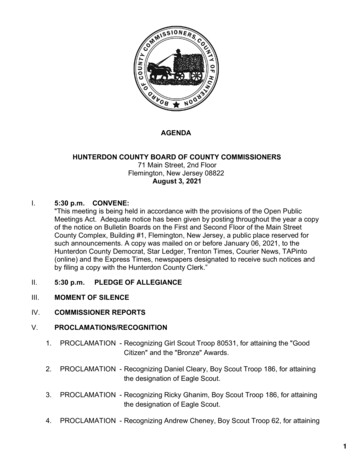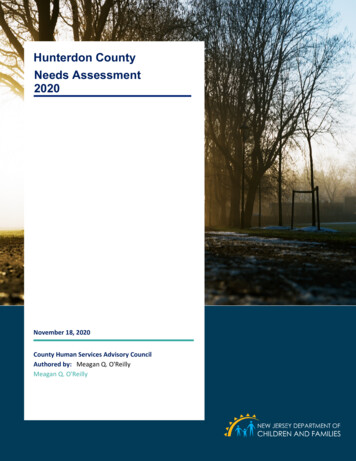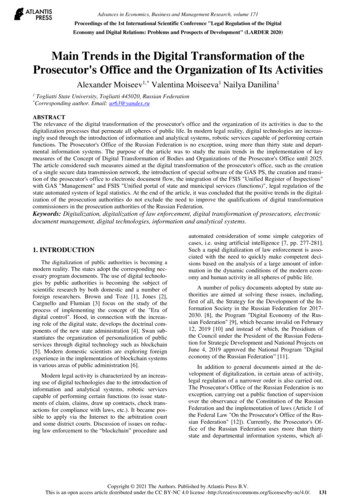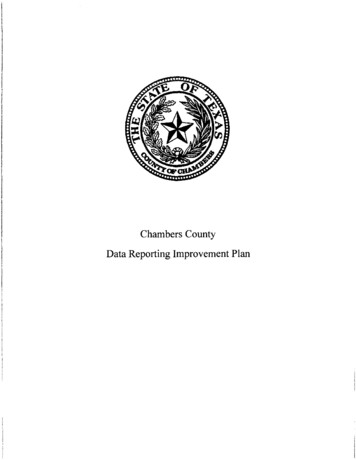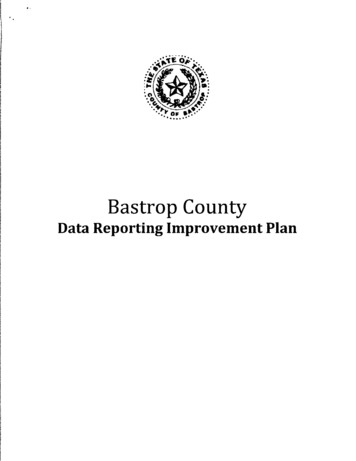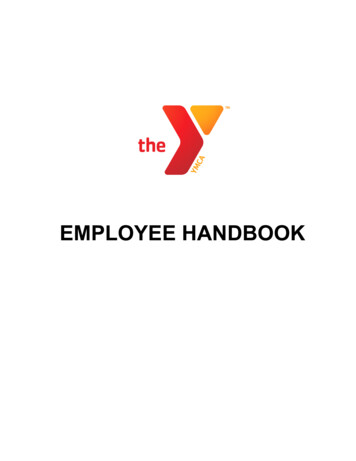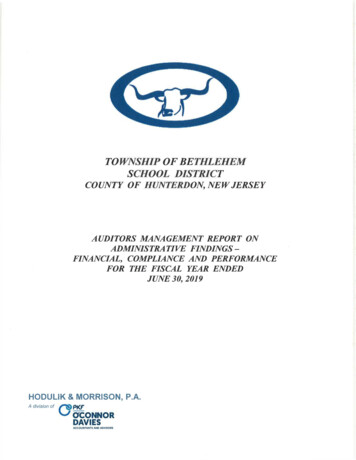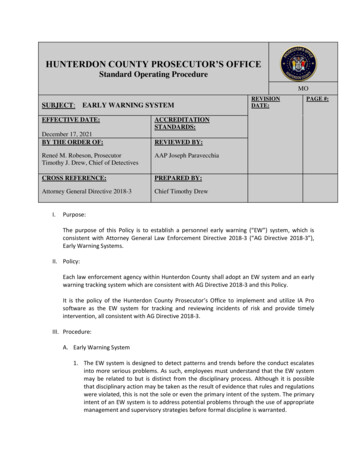
Transcription
HUNTERDON COUNTY PROSECUTOR’S OFFICEStandard Operating ProcedureMOSUBJECT:EARLY WARNING SYSTEMEFFECTIVE DATE:December 17, 2021BY THE ORDER OF:PAGE #:ACCREDITATIONSTANDARDS:REVIEWED BY:Reneé M. Robeson, ProsecutorTimothy J. Drew, Chief of DetectivesAAP Joseph ParavecchiaCROSS REFERENCE:PREPARED BY:Attorney General Directive 2018-3Chief Timothy DrewI.REVISIONDATE:Purpose:The purpose of this Policy is to establish a personnel early warning (“EW”) system, which isconsistent with Attorney General Law Enforcement Directive 2018-3 (“AG Directive 2018-3”),Early Warning Systems.II. Policy:Each law enforcement agency within Hunterdon County shall adopt an EW system and an earlywarning tracking system which are consistent with AG Directive 2018-3 and this Policy.It is the policy of the Hunterdon County Prosecutor’s Office to implement and utilize IA Prosoftware as the EW system for tracking and reviewing incidents of risk and provide timelyintervention, all consistent with AG Directive 2018-3.III. Procedure:A. Early Warning System1. The EW system is designed to detect patterns and trends before the conduct escalatesinto more serious problems. As such, employees must understand that the EW systemmay be related to but is distinct from the disciplinary process. Although it is possiblethat disciplinary action may be taken as the result of evidence that rules and regulationswere violated, this is not the sole or even the primary intent of the system. The primaryintent of an EW system is to address potential problems through the use of appropriatemanagement and supervisory strategies before formal discipline is warranted.
2. Many different measures of employee performance (actions or behavior) can beregularly examined for patterns or practices which indicate potentially escalating risk ofharm to the public, the agency, and/or the officer. The performance measures include,but are not limited to, the following documented indicators:a. Internal affairs complaints against the officer, whether initiated by another officer, amember of the public, anonymously;b. Civil actions filed against the officer;c. Criminal investigations of or criminal complaints against the officer;*d. Any use of force by the officer that is formally determined or adjudicated (forexample, by internal affairs or a grand jury) to have been excessive, unjustified, orunreasonable;e. Domestic violence investigations in which the officer is an alleged subject;f. An arrest of the officer, including on a driving under the influence charge;g. Sexual harassment claims against the officer;h. Vehicular collisions involving the officer that are formally determined to have beenthe fault of the officer;i. A positive drug test by the officer;j. Cases or arrests by the officer that are rejected or dismissed by a court;k. Cases in which evidence obtained by an officer is suppressed by a court;l. Insubordination by the officer;m. Neglect of duty by the officer;n. Unexcused absences by the officer; ando. Any other indicators, as determined by the agency’s chief executive.*NOTE: If EW System notification to the officer could jeopardize an ongoing criminalinvestigation, the County Prosecutor may in his or her discretion permit delayednotification to the officer or delayed initiation of the EW System review process.3. It is imperative that the supervisor, or appropriate command level officer, makenotification to the Internal Affairs Unit, who shall then make a timely entry in the IA Prosystem upon learning that one of the above triggers has been met.4. Three separate instances of performance indicators (as listed in Section 2, above) withinany twelve-month period will trigger the EW System review process. If one incidenttriggers multiple performance indicators, that incident shall not be double- or triplecounted, but instead shall count as only one performance indicator. The agencyexecutive may in his or her discretion determine that a lower number of performanceindicators within a twelve-month period (i.e., one or two performance indicators) willtrigger the EW system review process.B. Administration of Early Warning System1. The EW system is primarily the responsibility of the Internal Affairs Unit, but allsupervisors should be cognizant of potential early warning indicators for theirPage 2 of 6
subordinates. Emphasis should be placed on anticipating employee problems before itresults in improper performance or conduct.2. The Internal Affairs Unit shall be alerted by the IA Pro software if an employee has theemergence of a pattern, practices or trends of inappropriate behavior or misconduct. Inaddition, the Internal Affairs officer shall query the IA Pro software and review anindividual employee’s history any time a new complaint is received.3. Using this information and their experience, the Internal Affairs officer may be able toidentify employees who may need remedial/corrective intervention even before such isindicated by the IA Pro Software.4. In a case where a supervisor, who is not from the Internal Affairs Unit, makes an initialIA Pro entry and receives an EW alert for the involved officer(s), the supervisor shallprint out and forward the alert to the Internal Affairs Unit.5. If the IA Pro system indicated the emergence of a pattern, practices or trend ofinappropriate behavior or misconduct, the Internal Affairs officer shall, whenappropriate, consult with the employee’s supervisor and/or division commander.6. The Internal Affairs officer and, when appropriate, the employee’s supervisor and/orDivision or Unit Commander shall review the information provided by the InternalAffairs Unit along with any other relevant information from department records for thepurpose of initiating a course of intervention designed to correct/interrupt the emergingpattern, practice, or trend.7. If the IA Pro software has returned an incorrect identification or a “false positive,” thatconclusion must be documented.8. If the IA Pro software reveals that an employee has violated department rules andregulations or general orders, the supervisor in consultation with the Internal Affairsofficer should proceed with an internal investigation and possible disciplinary action.9. If the IA Pro software reveals that the employee has engaged in conduct which indicatesa lack of understanding or inability to comply with accepted procedures, the InternalAffairs Unit shall consult with the supervisor to determine the appropriate course ofremedial/corrective intervention.10. At least every six months, personnel assigned to manage the EW System shall audit theagency’s tracking system and records to assess the accuracy and efficiency of thetracking system.11. All agencies which operate under the oversight of the Hunterdon County Prosecutor’sOffice shall, upon initiation of the EW System review process, make a confidentialwritten notification to the Hunterdon County Prosecutor’s Office’s IA Unit of the identityof the subject officer, the nature of the triggering performance indicators, and theplanned remedial program. The notification shall be made by the agency’s chiefexecutive or designee.Page 3 of 6
12. All agencies which operate under the oversight of the Hunterdon County Prosecutor’sOffice shall, upon completion of the EW System review process, make a confidentialwritten notification to the County Prosecutor or his/her designee of the outcome of theEW System review, including any remedial measures taken on behalf of the subjectofficer. The notification shall be made by the agency’s chief executive or designee.C. Remedial/Corrective Action1. When it has been determined that an officer has displayed the requisite number ofperformance indicators necessary to trigger the EW System review process (as set forthin Section III.B., above) assigned supervisory personnel shall initiate remedial action toaddress the officer’s behavior.2. When an EW System review process is initiated,* personnel assigned to oversee the EWSystem should:a.b.c.d.e.Formally notify the subject officer in writing;Conference with the subject officer and appropriate supervisory personnel;Identify problems or potential problems;Determine short and long-term goals of improvement;Come to a consensus commitment on a plan for long-term improvedperformance;f. Advise of the monitoring process and the repercussions of future sustainedtransgressions;g. Develop and administer a remedial program, including the appropriateremedial/corrective actions listed below;h. Continue to monitor the subject officer for at least three months, or until thesupervisor concludes that the officer’s behavior has been remediated(whichever is longer);i. Document and report findings to the appropriate supervisory personnel and, ifwarranted, the Internal Affairs Unit.*NOTE: Any statement made by the subject officer in connection with the EWSystem review process may not be used against the subject officer in anydisciplinary or other proceeding.3. Remedial/corrective action may include but is not limited to the following:a.b.c.d.e.f.Training or re-training;Counseling;Intensive supervision;Fitness-for-duty examination;Employee Assistance Program (EAP) referral; andAny other appropriate remedial or corrective action.Page 4 of 6
4. Internal disciplinary action, remedial/corrective intervention, and fitness for dutyexaminations ensure that such actions are not mutually exclusive and should be jointlypursued if and when appropriate.5. When remedial/corrective action intervention has been undertaken, the Chief ofDetectives, or designee, shall ensure that such actions are documented in writing. Noentry should be made in the employee’s personnel file, unless the action results in asustained IA investigation. If the remedial/corrective intervention is a training program,attendance and successful completion of that program should be noted in theemployee’s training record.6. All reports shall be forwarded to the Chief of Detectives for review. These reports havethe same confidential status as internal affairs documents and are subject to the samedisclosure and retention regulations and guidelines.7. This policy and EW Systems generally, are focused on corrective actions to remediateofficer behavior and to provide assistance to the officer. This Policy, and EW Systemsgenerally, do not address disciplinary actions that might be warranted against an officer.Such disciplinary actions, to include the decision to suspend, terminate or, if applicable,charge an officer with criminal conduct, remain within the purview of the agency’sinternal affairs guidelines and applicable law, separate from and independent of the EWSystem.D. Supervisors1. An employee’s first line supervisor is usually the first member of the department toencounter and document specific incidents that affect an employee. It is essential forthe supervisor to speak with the employee, document these incidents and, if warranted,the Internal Affairs Unit. The success of this program relies heavily on the first linesupervisor’s participation and involvement.2. It is imperative that the supervisor, or appropriate command level officer, makenotification to the Internal Affairs Unit, who shall then make a timely entry in the IA Prosystem upon learning that one of the above triggers in section III.A.2 above has beenmet.3. Division commanders shall periodically review an individual employee’s history. Usingthis information and their experience, the division commander may be able to identifyemployees who may need remedial/corrective intervention even before such isindicated by the IA Pro software.E. Notification to Subsequent Law Enforcement Employer1. If any officer who is or has been subject to an EW System review process applies to oraccepts employment at a different law enforcement agency it is the responsibility of theInternal Affairs officer to notify the subsequent employing law enforcement agency ofthe officer’s EW System review process history and outcomes.Page 5 of 6
2. Upon request, this agency shall share the officer’s EW System review process files withthe subsequent employing agency.F. Annual Reporting1. By January 15th of each year, each law enforcement agency under the supervision of theHunterdon County Prosecutor’s Officer shall submit a written report to the HCPO IA unitindicating their compliance with AG Directive 2018-03.2. By January 31st of each year, the Hunterdon County Prosecutor’s Office IA unit shallsubmit a report to the Attorney General, through the Division of Criminal Justice'sProsecutors' Supervision and Training Bureau. This summary shall include a statementindicating those agencies under the County Prosecutor's supervision that are incompliance with this Directive and those that are not.G. Public Accessibility and Confidentiality1. This EW System Policy shall be made available to the public upon request and shall beposted on the agency’s website.2. All written reports created or submitted pursuant to this Policy that identify specificofficers are confidential and not subject to public disclosure.All procedures heretofore employed by the Hunterdon County Prosecutor’s Office thatconflict with this Policy are hereby rescinded. Supervisors shall be held accountable forthe enforcement and application of this Policy. All members of the Hunterdon CountyProsecutor’s Office are required to follow this Policy as applicable. Violations of thisPolicy subject members of this agency to disciplinary action. If there is a discrepancy orconflict between this Policy and Attorney General Law Enforcement Directive No. 2018-3,the Directive shall prevail.######Page 6 of 6
It is the policy of the Hunterdon County Prosecutor's Office to implement and utilize IA Pro software as the EW system for tracking and reviewing incidents of risk and provide timely intervention, all consistent with AG Directive 2018-3. III. Procedure: A. Early Warning System 1.
